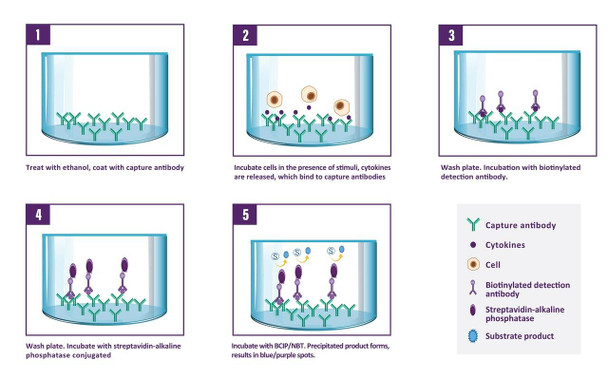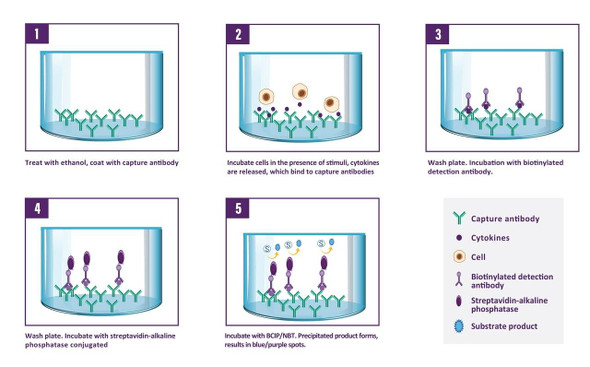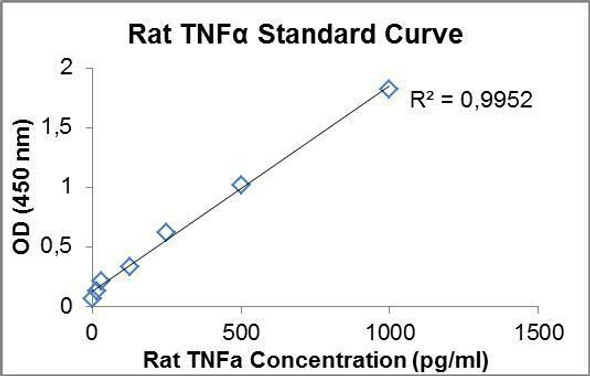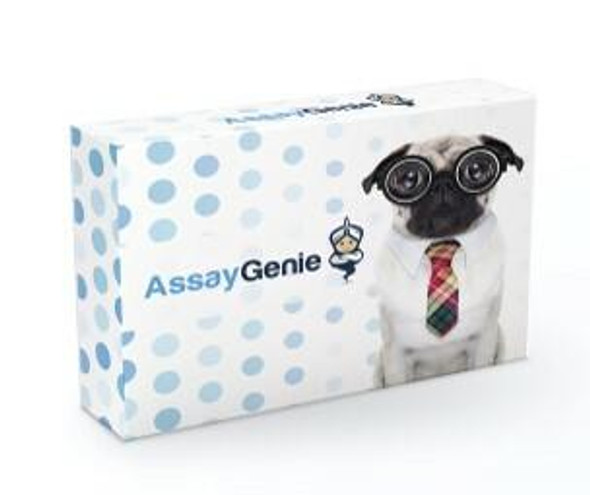Description
Rat TNF-alpha ELISpot Kit
Assay Genie ELISpot is a highly specific immunoassay for the analysis of TNF-α production and secretion from T-cells at a single cell level in conditions closely comparable to the in-vivo environment with minimal cell manipulation. This technique is designed to determine the frequency of TNF-α producing cells under a given stimulation and the comparison of such frequency against a specific treatment or pathological state. Utilising sandwich immuno-enzyme technology, Assay Genie ELISpot assays can detect both secreted TNF-α (qualitative analysis) and single cells that produce TNF-α (quantitative analysis). Cell secreted TNF-α is captured by coated antibodies avoiding diffusion in supernatant, protease degradation or binding on soluble membrane receptors. After cell removal, the captured TNF-α is revealed by tracer antibodies and appropriate conjugates.
| Product type: | ELISpot Kit |
| Size: | 10 x 96 Assays |
| Target species: | Rat |
| Specificity: | Recognizes natural rat TNF-α |
| Incubation: | 3h after cell stimulation |
| Kit content: | Assay Genie Pre-coated ELISpot kits include precoated PVDF plates, Detection antibody, Alkaline phosphatase conjugate, BSA, BCIP/NBT ready-to-use substrate buffer. |
| Synonyms: | TNF-a, TNF-alpha |
| Uniprot: | P16599 |
A capture antibody highly specific for TNF-α is coated to the wells of a PVDF bottomed 96 well microtitre plate either during kit manufacture or in the laboratory. The plate is then blocked to minimise any non-antibody dependent unspecific binding and washed. Cell suspension and stimulant are added and the plate incubated allowing the specific antibodies to bind any TNF-α produced. Cells are then removed by washing prior to the addition of Biotinylated detection antibodies which bind to the previously captured TNF-α. Enzyme conjugated streptavidin is then added binding to the detection antibodies. Following incubation and washing, substrate is then applied to the wells resulting in coloured spots which can be quantified using appropriate analysis software or manually using a microscope.
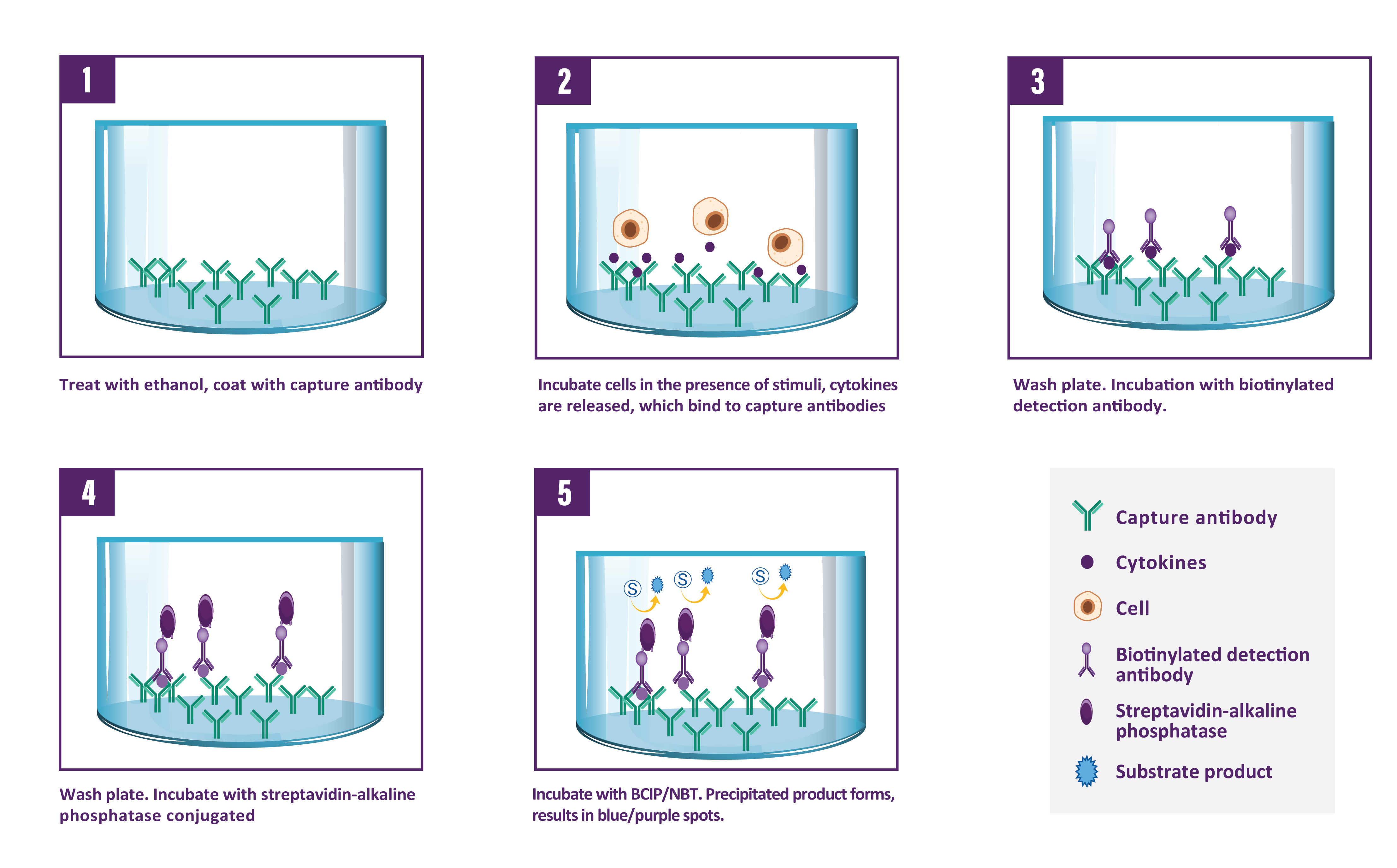
| Step | Procedure |
| 1. | For PVDF membrane activation, add 25 µl of 35% ethanol to every well. |
| 2. | Incubate plate at room temperature (RT) for 30 seconds. |
| 3. | Empty the wells by flicking the plate over a sink & gently tapping on absorbent paper. Thoroughly wash the plate 3x with 100 µl of PBS 1X per well. |
| 4. | Add 100 µl of diluted capture antibody to every well. |
| 5. | Cover the plate and incubate at 4°C overnight. |
| 6. | Empty the wells as previous and wash the plate once with 100 µl of PBS 1X per well. |
| 7. | Add 100 µl of blocking buffer to every well. |
| 8. | Cover the plate and incubate at RT for 2 hours. |
| 9. | Empty the wells as previous and thoroughly wash once with 100 µl of PBS 1X per well. |
| 10. | Add 100 µl of sample, positive and negative controls cell suspension to appropriate wells providing the required concentration of cells and stimulant. |
| 11. | Cover the plate and incubate at 37°C in a CO2 incubator for an appropriate length of time (15-20 hours). Note: do not agitate or move the plate during this incubation. |
| 12. | Empty the wells and remove excess solution then add 100 µl of Wash Buffer to every well. |
| 13. | Incubate the plate at 4°C for 10 min. |
| 14. | Empty the wells as previous and wash the plate 3x with 100 µl of Wash Buffer. |
| 15. | Add 100 µl of diluted detection antibody to every well. |
| 16. | Cover the plate and incubate at RT for 1 hour 30 min. |
| 17. | Empty the wells as previous and wash the plate 3x with 100 µl of Wash Buffer. |
| 18. | Add 100 µl of diluted Streptavidin-conjugate to every well. |
| 19. | Cover the plate and incubate at RT following the supplier's instructions. |
| 20. | Empty the wells and wash the plate 3x with 100 µl of Wash Buffer. |
| 21. | Peel of the plate bottom and wash both sides of the membrane 3x under running distilled water, once washing complete remove any excess solution by repeated tapping on absorbent paper. |
| 22. | Add 100 µl of ready-to-use substrate buffer to every well. |
| 23. | Following the supplier's instructions, incubate the plate for 5-15 min monitoring spot formation visually throughout the incubation period to assess sufficient colour development. |
| 24. | Empty the wells and rinse both sides of the membrane 3x under running distilled water. Completely remove any excess solution by gentle repeated tapping on absorbent paper Read Spots: allow the wells to dry and then read results. The frequency of the resulting coloured spots. |
| UniProt Protein Function: | TNF-a: Cytokine that binds to TNFRSF1A/TNFR1 and TNFRSF1B/TNFBR. It is mainly secreted by macrophages and can induce cell death of certain tumor cell lines. It is potent pyrogen causing fever by direct action or by stimulation of interleukin-1 secretion and is implicated in the induction of cachexia, Under certain conditions it can stimulate cell proliferation and induce cell differentiation. Homotrimer. Interacts with SPPL2B. Belongs to the tumor necrosis factor family. |
| UniProt Protein Details: | Protein type:Motility/polarity/chemotaxis; Membrane protein, integral; Cytokine; Apoptosis Cellular Component: extracellular space; recycling endosome; cell surface; integral to plasma membrane; integral to membrane; plasma membrane; intracellular; external side of plasma membrane; phagocytic cup; lipid raft Molecular Function:identical protein binding; protease binding; cytokine activity; tumor necrosis factor receptor binding Biological Process: extracellular matrix organization and biogenesis; positive regulation of nitric oxide biosynthetic process; positive regulation of NFAT protein import into nucleus; activation of MAPK activity; positive regulation of apoptosis; positive regulation of transcription, DNA-dependent; positive regulation of caspase activity; positive regulation of translational initiation by iron; positive regulation of membrane protein ectodomain proteolysis; activation of NF-kappaB transcription factor; positive regulation of MAP kinase activity; cellular extravasation; tumor necrosis factor-mediated signaling pathway; positive regulation of phagocytosis; negative regulation of interleukin-6 production; JNK cascade; negative regulation of osteoblast differentiation; positive regulation of action potential; embryonic gut development; negative regulation of protein complex disassembly; response to drug; positive regulation of cytokine production; positive regulation of heterotypic cell-cell adhesion; positive regulation of mitosis; response to virus; positive regulation of interleukin-6 production; glucose metabolic process; negative regulation of cytokine secretion during immune response; positive regulation of protein transport; DNA damage response, signal transduction resulting in induction of apoptosis; response to mechanical stimulus; defense response to bacterium; positive regulation of transcription from RNA polymerase II promoter; skeletal muscle contraction; sequestering of triacylglycerol; positive regulation of JNK cascade; negative regulation of transcription from RNA polymerase II promoter; signal transduction; positive regulation of interleukin-18 production; chronic inflammatory response to antigenic stimulus; positive regulation of hair follicle development; negative regulation of cell proliferation; positive regulation of neuron apoptosis; protein kinase B signaling cascade; positive regulation of chronic inflammatory response to antigenic stimulus; inflammatory response; regulation of protein amino acid phosphorylation; transformed cell apoptosis; positive regulation of peptidyl-serine phosphorylation; humoral immune response; regulation of cell proliferation; positive regulation of protein kinase B signaling cascade; positive regulation of interferon-gamma production; positive regulation of programmed cell death; positive regulation of protein complex assembly; negative regulation of viral genome replication; response to hypoxia; regulation of insulin secretion; positive regulation of JNK activity; positive regulation of osteoclast differentiation; multicellular organismal development; response to glucocorticoid stimulus; response to lipopolysaccharide; positive regulation of NF-kappaB import into nucleus; osteoclast differentiation; regulation of immunoglobulin secretion; positive regulation of I-kappaB kinase/NF-kappaB cascade; positive regulation of interleukin-8 biosynthetic process; positive regulation of chemokine production; cell activation; detection of mechanical stimulus involved in sensory perception of pain; organ morphogenesis; defense response to Gram-positive bacterium; induction of apoptosis via death domain receptors; positive regulation of transcription factor activity; negative regulation of L-glutamate transport; response to activity; negative regulation of transcription, DNA-dependent; leukocyte migration; apoptosis; positive regulation of smooth muscle cell proliferation; defense response; positive regulation of synaptic transmission; response to radiation; regulation of protein secretion; regulation of osteoclast differentiation; negative regulation of lipid catabolic process; lipopolysaccharide-mediated signaling pathway; regulation of I-kappaB kinase/NF-kappaB cascade; caspase activation; positive regulation of humoral immune response mediated by circulating immunoglobulin; positive regulation of protein complex disassembly; calcium-mediated signaling; MAPKKK cascade; negative regulation of glucose import; positive regulation of chemokine biosynthetic process; protein import into nucleus, translocation; positive regulation of protein kinase activity; positive regulation of fever; activation of MAPKKK activity; positive regulation of protein amino acid phosphorylation; receptor biosynthetic process; leukocyte tethering or rolling; negative regulation of myoblast differentiation; positive regulation of inflammatory response; positive regulation of cytokine secretion |
| NCBI Summary: | acts as a cytokine; binds TNF receptors; plays a role in regulation of cell proliferation, induction of apoptosis, and inflammatory response [RGD, Feb 2006] |
| UniProt Code: | P16599 |
| NCBI GenInfo Identifier: | 135938 |
| NCBI Gene ID: | 24835 |
| NCBI Accession: | P16599.1 |
| UniProt Secondary Accession: | P16599,Q6EE11, Q9JI26, Q9JI27, |
| UniProt Related Accession: | P16599 |
| Molecular Weight: | 25,806 Da |
| NCBI Full Name: | Tumor necrosis factor |
| NCBI Synonym Full Names: | tumor necrosis factor |
| NCBI Official Symbol: | Tnf‚ ‚ |
| NCBI Official Synonym Symbols: | Tnfa; RATTNF; TNF-alpha‚ ‚ |
| NCBI Protein Information: | tumor necrosis factor; cachectin; tumor necrosis factor alpha; tumor necrosis factor (TNF superfamily, member 2); tumor necrosis factor ligand superfamily member 2 |
| UniProt Protein Name: | Tumor necrosis factor |
| UniProt Synonym Protein Names: | Cachectin; TNF-alpha; Tumor necrosis factor ligand superfamily member 2; TNF-a |
| Protein Family: | Tumor necrosis factor |
| UniProt Gene Name: | Tnf‚ ‚ |
| UniProt Entry Name: | TNFA_RAT |

